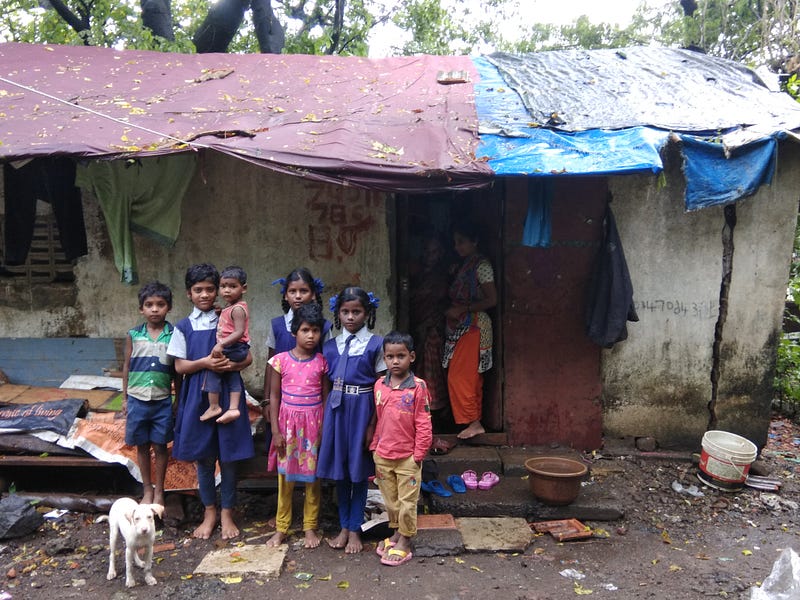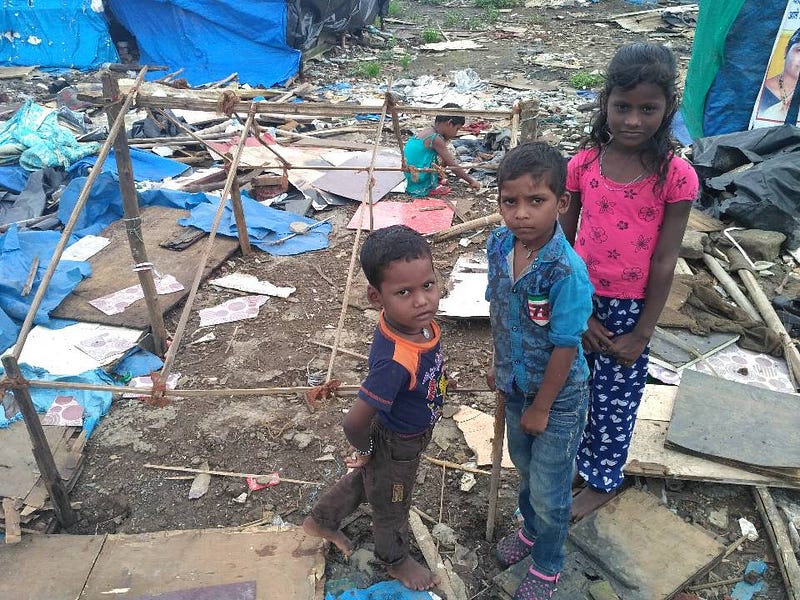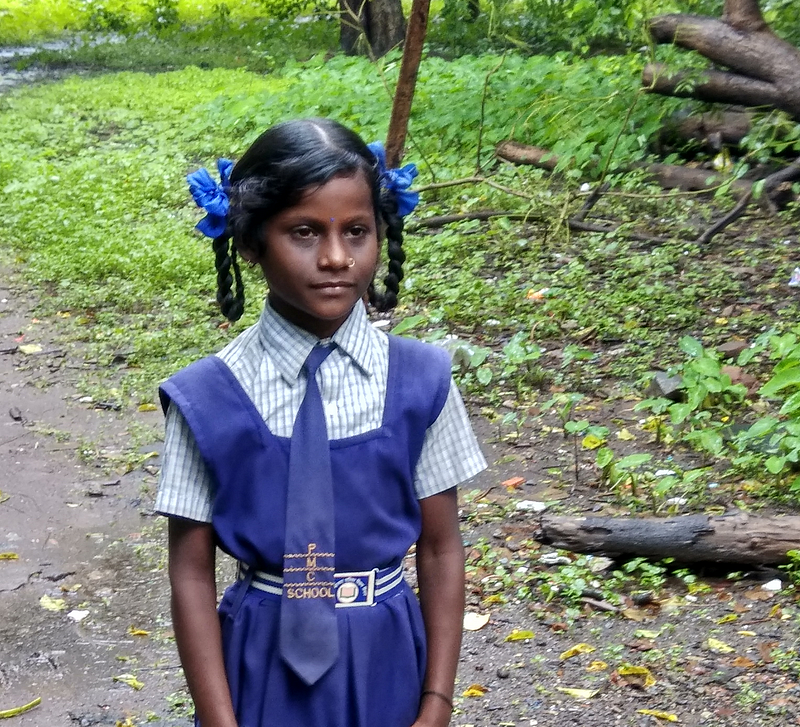What happens when evictions become a frequented reality in one’s life? Sometimes, children start building a safe space of their own, even before they can play. Presenting one such story from Navi Mumbai.

Losing Home, Again
A little over a year ago, when houses in the informal settlement of Mata Ramai Nagar, Khanda Colony, Panvel, were demolished Jyoti’s house was one of the many structures razed. In the days that followed, as the family pieced together their belongings and began re-making their home, class IV student Jyoti and her siblings played a game they had never played before. They started building a small house, exactly in the way they had seen their parents rebuild their home each time it had been destroyed. ‘We’ve seen people building houses around us so many times. We thought, why not give it a try’, she said, going on to explain the process chronologically.
‘First we dug a hole, then we got the sticks together which would form the frame of the house. We had to cut them precisely, breaking them with a spear which we managed to get from one of our family members. We tied the sticks together with a string, and then we attached paper on the roof of the house. It was ready to be used,’ she said confidently. When asked where she managed to get all the material to build this house, she said she used what was lying around her, pieces of her own home and her neighbours, left behind after the demolition.
Another Fragile Home for Play
The makeshift house constructed by Jyoti and her siblings became their play space for the next few days. They would eat and sleep there, and play at entertaining guests, pretending to cook meals too. The house lasted for another week before the civic authorities arrived for another set of demolitions, razing it to the ground, again. They tried to build another home a few months later, but Jyoti’s brother jumped on it and it broke. The pieces were fed to their stove as dinner was being cooked.

Experiencing Evictions
YUVA’s recent report highlights how, since 2015, forced evictions in Navi Mumbai have drastically risen. While communities never evicted since being formed in the early 90s were now being evicted for the first time, those who were evicted twice a year earlier experienced twice-a-month evictions in 2016, largely driven by infrastructure development plans, metro railway constructions, and city beautification projects. In the case of Mata Ramai Nagar, located on City and Industrial Development Corporation (CIDCO) land, the Panvel Municipal Corporation drove evictions.
Given the frequent spate of evictions, children are no longer unfamiliar with these processes. ‘Many a time, we have had to go for work even when there was a threat of eviction, else our employers threatened to fire us. The children at home packed up our belongings and kept it outside the house to reduce our losses,’ says Sunita Sawar, Jyoti’s aunt, who works as house help in the nearby areas. During one eviction drive, as Jyoti was running away from the bulldozers, three nails got lodged in her feet. ‘I ran towards her to rescue her, and received blows from the municipal authority in return,’ said her grandmother.
Repeated evictions have often led to loss of school books and uniforms. ‘Fed up with these mounting losses, once we walked to the local MLA’s house with the children, spending the night on the road to protest against the injustice caused to us. He didn’t meet us,’ said Sunita. When asked how they respond to evictions, Pooja, Jyoti’s cousin mentioned how she feels scared. At Mata Ramai Nagar they would be stranded in at the time of evictions, with the railway tracks on one side of them and constructions on the other side. There was no place to go. Many people were also jailed during the time of evictions, especially the men.
Adjusting to Home Away from Home

On the day we met Jyoti, she returned home from school with her siblings at 5 pm. As we waited for her in the family’s temporary one-room structure at Khanda Colony, talking to her parents, aunt and grandmother, all of whom live together, they told us why they were living there now. The rains had ravaged their former home, and it was impossible to live there. A builder on the same site had created a construction which was directing water into their homes and those of their neighbours. Already, some people in the neighbourhood had slipped, fallen into the water and died. The family considers themselves lucky that they could move here for the rainy months. ‘Snakes and scorpions were entering the house. It was becoming really unsafe. Besides, the children were constantly falling sick in that damp and wet house,’ says Sunita.
The current house is not bereft of dampness either. The walls are thinly plastered, with large gaps in between. But they have access to electricity here, something that was denied to them in their former home. ‘We lived in a pucca house earlier but it was demolished. We have lived in Mata Ramai Nagar since 2002. When we moved, there were just 10–12 families in the area. Over the years, the settlement increased in size and currently there are approximately 150–200 households there,’ said Ratna, Jyoti’s mother.
The family’s earnings are mostly spent on food and medicines. The 11 family members residing in the one-room structure are cramped for space. ‘We have struggled a lot through our lives. We only hope that with the education they receive our children can build a better life and home for themselves,’ says Ratna.
Going to School
Jyoti’s current school is over 4 km away from their house. The 5 siblings (including Jyoti and her cousins) pile onto 2 cycles, driving them amidst the traffic on the roads. The parents worry about their safety on the road, but they are unable to provide any other option for them. Once they are back from school, the children go to fill water in the neighbourhood. Then they sit down to complete their homework and if they get any more time they watch some TV. ‘We miss our friends from Mata Ramai Nagar. Some of them have returned to their village, others are still living there. A few of them come over here sometimes and we play catch or kho-kho with them,’ says Jyoti.
Frequently Displaced
Jyoti’s family is just one of hundreds getting regularly evicted from a place they call home. In Navi Mumbai, families experiencing these threats number in thousands. While Jyoti’s family has been lucky to find another temporary home and the children have been able to continue with school, others are not so fortunate. When the house is razed down, children frequently find themselves homeless and out of school given their displacement, the increased distance from school (if resettled elsewhere), and the losses suffered. The lack of data on the number of children affected during evictions highlights the invisibilisation of the issue and the glaring gap waiting to be addressed.
In such situations, what is unthinkable often becomes a part of reality. Children learn how to build a home; those around them don’t react to this enactment, knowing how evictions frequent their daily lives.
#UprootedChildhoods is a collaboration between YUVA and Leher, attempting to spark dialogue on a critical yet oft invisibilised concern — the views of children on housing. The campaign draws from YUVA’s in-depth interventions with children over the years across cities, and Leher’s focus and commitment to child rights, with a preventive approach towards child protection. Through the different blogs, photo essays, video stories, infographics and other formats we hope to present many faces of urban childhoods. Stay tuned.



